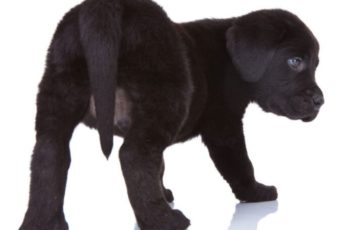This post may contain affiliate links. We may earn money or products from the companies mentioned in this post.
If you’ve adopted a dog from a shelter or rescue organization, you probably bought a large variety of dog toys for them.
Or maybe your late pup had a huge toy collection, and you’d love for your rescue dog to show the same tail wagging enthusiasm for it.
But what if your new furry friend only takes a polite sniff at the toys and then walks away?
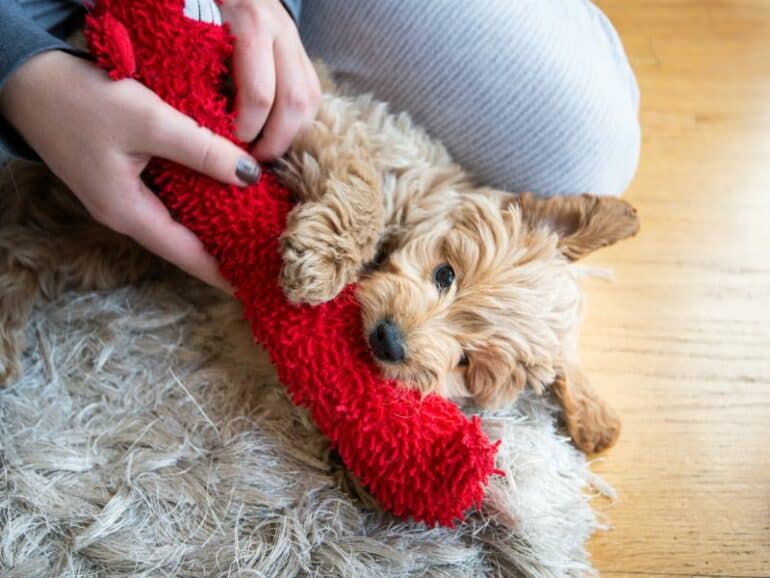
So the question is, how to teach a rescue dog to play with toys.
Well, the good news is that there are a few options that we’ll look at in this blog post.
However, it’s also important to understand that just like humans, dogs have individual preferences and personalities.
That’s why some dogs love chasing balls and frisbees, while others have a lower play drive or don’t care for dog toys at all.
As a matter of fact, my rescue pup Wally falls into the low play drive category, and there’s only two types of toys he’s truly interested in – plush toys and squeaky/crinkly ones.
Either way, for those low play drive pups, it’s important to respect their individuality and find alternative ways to provide mental and physical stimulation.
No worries, I’ll also share ways to achieve that without traditional toys like balls and frisbees.
But first, let’s look at possible reasons why your rescue dog might not want to play with toys in general.
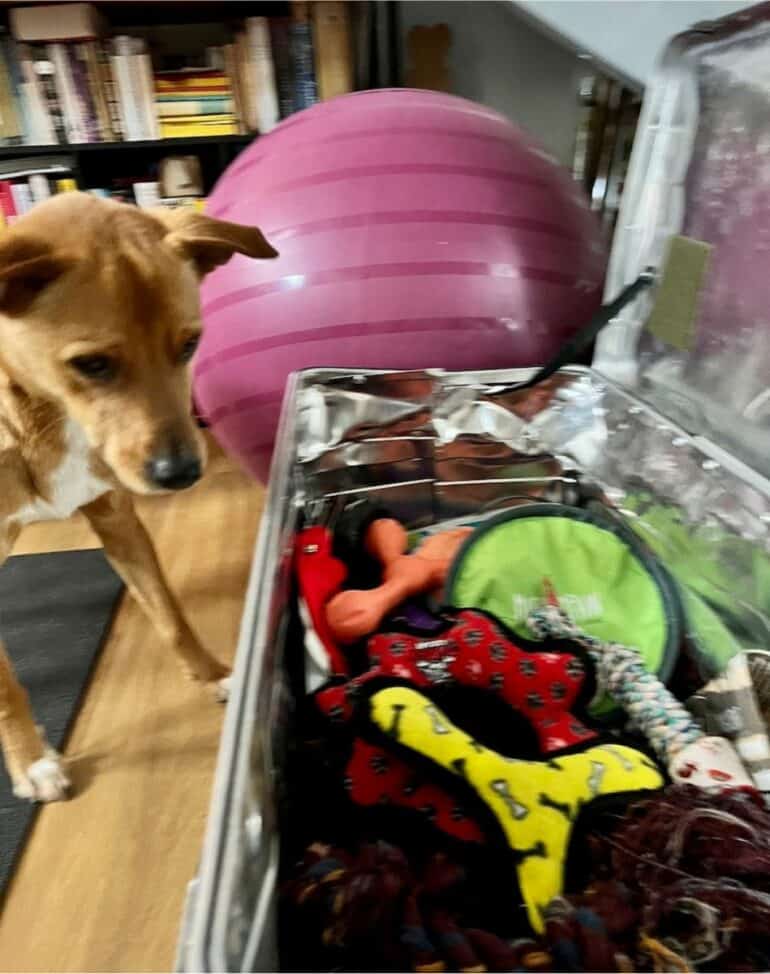
Wally’s not impressed with the collection of toys from my previous dogs
Why Do Some Rescue Dogs Don’t Like To Play With Toys?
Beyond a lower play drive, there are several other reasons why some rescue dogs may not show interest in playing with dog toys:
Traumatic Past Experiences
A past traumatic experience can have a significant impact on a rescue dog’s behavior, including their desire to play with toys.
If the traumatic experience involved humans or toys, the pup may be wary of interacting with toys due to a lack of trust. They may fear that playing with toys could lead to further harm or negative experiences.
Certain toys or play behaviors might also remind them of the traumatic experience, triggering stress or fear responses.
For example, if a dog was injured while playing tug-of-war with a rope toy, they might associate that toy with pain or danger.
Some dogs who have experienced trauma can also easily be overstimulated, particularly by toys that make noise or have sudden movements.
Lack of Exposure to Dog Toys
Some rescue dogs may not have been exposed to dog toys during the first 4 months of their lives.
That’s a critical, formative time for puppies, so they may not understand the purpose of dog toys.
These dogs may require patient guidance and positive reinforcement to understand that dog toys are meant for play and enjoyment.
Anxiety or Fear
Some rescue dogs may experience anxiety or fear, which can inhibit their desire to play.
Anxiety-related issues could stem from their previous experiences or from adjusting to a new environment.
If that’s the case with your rescue dog, it’s important to create a calm and safe environment and gradually introduce toys at their own pace.
Health Issues
Dogs that are in pain or discomfort due to underlying health issues may not feel inclined to play with toys.
Of course this doesn’t just apply to rescue dogs, but to all dogs in general.
So if you suspect that any health issues like arthritis or dental issues may interfere with your dog’s willingness to play with toys, go ahead and schedule a vet visit.
It’s essential to rule out any medical conditions that may be causing discomfort or pain, and address them accordingly.
How To Teach A Rescue Dog To Play With Toys
Now that we know why your rescue dog does not want to play with his toys, let’s get started with…
Ideas To Encourage Your Rescue Dog To Engage With Toys
Now, to help a rescue dog overcome their aversion to toys, it’s important to proceed with patience, understanding, and positive reinforcement.
Next up are some ideas for how to teach a rescue dog that playtime with toys can be fun!
Start with Gentle Introductions
Begin by presenting the toy to your dog in a calm and non-threatening way – there’s no need to immediately toss it at them!
Instead, let them sniff and investigate the toy at their own pace. Use a soft and inviting tone of voice to create a positive association with the experience.
If they show signs of anxiety or fear, remove the toys and try again later.
Choose The Right Dog Toys For Your Rescue Dog
Different dogs have different preferences when it comes to the toys they’re interested in.
For instance, some dogs prefer squeaky toys over frisbees, while others like tug-of-war toys much better than balls, and others yet again will drop everything for a chew toy or an interactive puzzle toy.
That’s why I suggest you experiment with a variety of dog toys to discover what type your rescue dog enjoys.
But regardless of the toys you offer your pup, make sure that they are safe, durable, and suitable for your pup’s size and breed.
If you notice that your dog doesn’t care for loud noises, avoid toys that make sounds or have sudden movements until they feel more comfortable.
As far as Wally is concerned, he doesn’t care for any of these toys:
However, he LOVES squeaky chuck-it balls and plush dog toys!
And while he’ll happily shred any plush toy, Wally has a special kind of love for squeaky plush toys, followed by plush dog toys with crinkle paper.
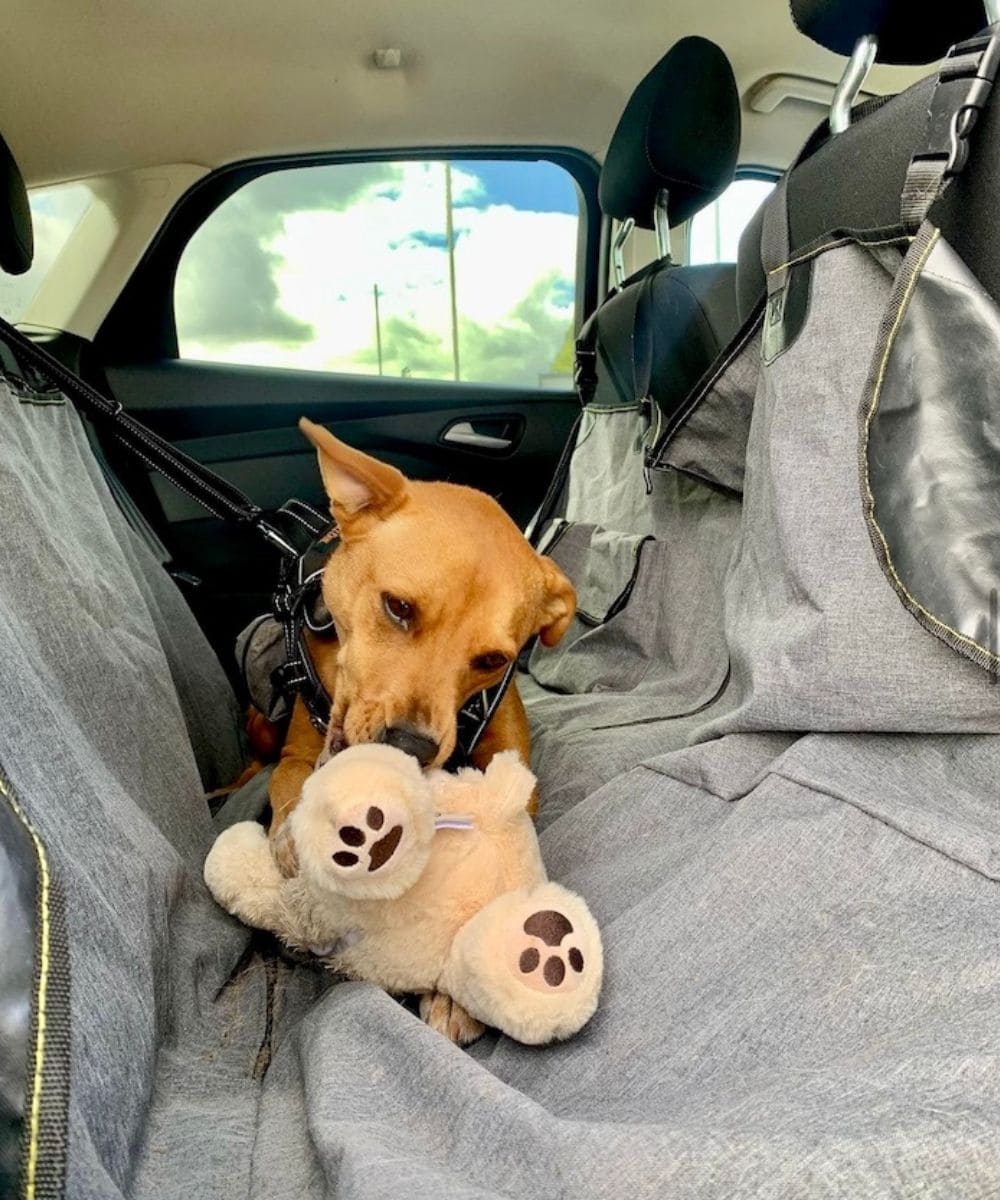
My rescue dog Wally with a plush dog toy he “kidnapped” from a pet retail store!
As far as dog chew toys are concerned, it’s usually hit or miss unless it’s edible like:
Since he’s extremely food motivated, he also loves dog puzzles like filled KONGs and treat dispensing toys.
But I kid you not, the moment they’re empty, he’s done with them!
Use Treat-Dispensing Dog Toys
On that note, if you have a food-motivated dog like Wally, try combining playtime with treat rewards by using toys that dispense treats when your dog interacts with them.
You can use treat dispensing toys like the:
This can help motivate your rescue dog to engage with the toy and make it a positive experience.
Start by placing a few treats inside the toy and show your dog how to get the treats out.
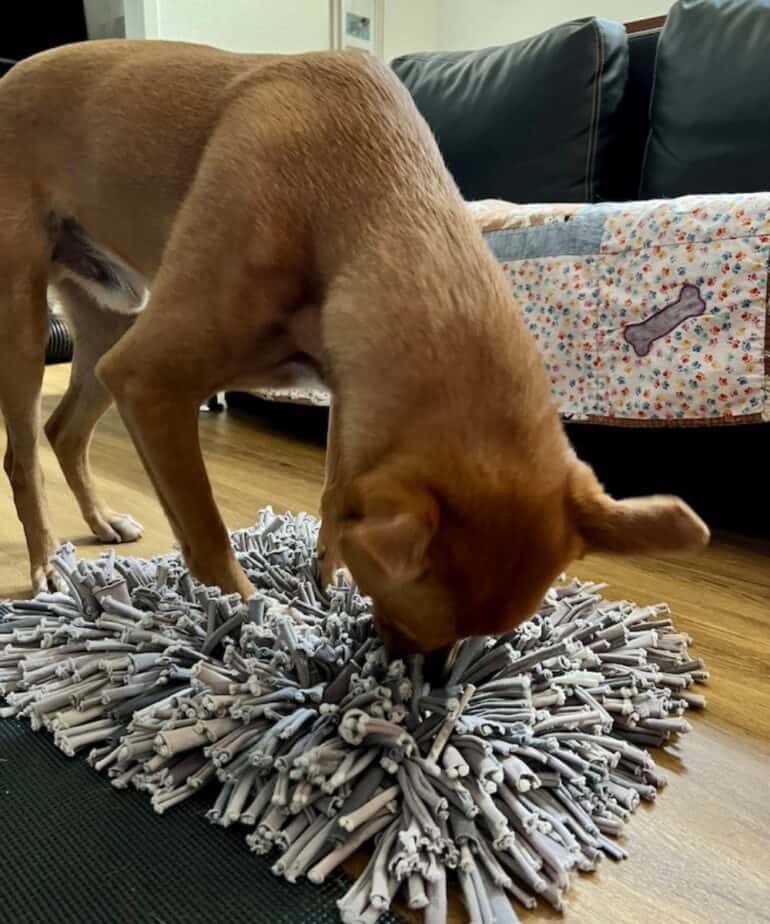
My rescue pup Wally with his Snuffle Mat
Play Interactive Games
Sometimes, dogs don’t want to play by themselves, they want you to participate!
So try to engage in interactive play with your rescue dog to make the toy more enticing.
Tug-of-war or fetch are great games to play with your dog.
You can use a rope dog toy or a long fetch toy to get them interested in the game.
Hold one end and offer them the other end!
Demonstrate Enthusiasm
You may know that dogs respond to the energy and enthusiasm of their humans.
So show excitement when you’re playing with the toy to pique your dog’s interest.
You can use animated gestures, an enthusiastic tone of voice and verbal praise. Yay, good boy!
Whatever you do, the goal is to convey to your rescue dog that playing with toys is fun!
Rotate Your Rescue Dog’s Toys
Dogs who have baskets full of toys can experience something that’s known as toy fatigue.
To prevent that, simply rotate your rescue pup’s toys regularly. For example, on a weekly or bi-weekly basis.
This prevents your dog from becoming bored with the same toys and keeps their interest piqued.
Of course you can also introduce new toys periodically to provide novelty and excitement.
Plus it’s FUN to shop for new doggie things, right?!
Play With Other Dogs
If possible, arrange playdates with other friendly and well-socialized dogs who aren’t toy possessive.
That’s because dogs are often more inclined to play with a toy when they see other dogs having fun with it!
Another side effect is that positive interactions with other dogs can help your rescue dog learn how to (nicely) play with toys by observing their doggie playmates.
Bottom Line
When you’re working on teaching your rescue dog how to play with toys, remember that each dog is unique and has a different background.
That means it may take time and patience to find the toys and play styles that your rescue dog enjoys.
In order to identify your dog’s preferences, observe their behavior and reactions to different types of toys.
Determine if they prefer:
- Dog chew toys
- Interactive puzzle toys
- (Squeaky) plush dog toys
- Fetch toys like frisbees, balls and bumper toys
- Tug-of-war toys like rope toys and long rubber toys
That said, also remember that they may associate (certain) toys with negative experiences, which is why it may take time for them to build trust and feel comfortable exploring new dog toys.
And who knows, maybe your rescue dog is just not that much into dog toys because they have a lower play drive, just like Wally.
So your best approach is to be understanding, offer positive reinforcement, and make the experience enjoyable for your furry friend.
How did you teach your rescue dog to play with toys? Let us know in the comment section below this blog post!
Save To Pinterest
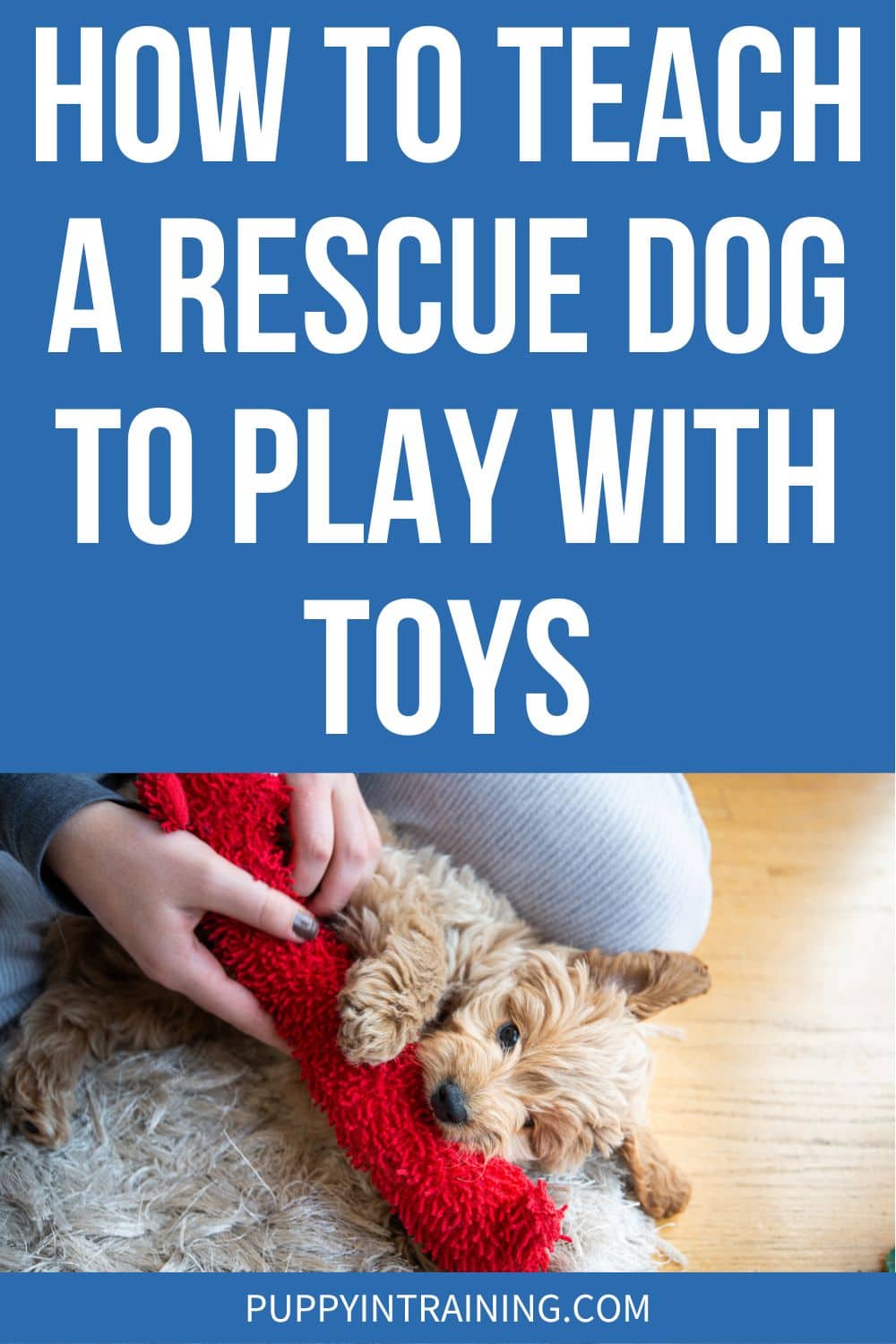
Top Picks For Our Puppies
- BEST PUPPY TOY
We Like: Calmeroos Puppy Toy w/ Heartbeat and Heat Packs – Perfect for new puppies. Helps ease anxiety in their new home. - BEST DOG CHEW
We Like: Mighty Paw Naturals Bully Sticks – All of our puppies love to bite, nip, and chew. We love using Bully Sticks to help divert these unwanted behaviors. - BEST DOG TREATS
We Like: Crazy Dog Train-Me Treats – We use these as our high-value treats for our guide dog puppies. - BEST FRESH DOG FOOD
We Like: The Farmer’s Dog – A couple months ago we started feeding Raven fresh dog food and she loves it! Get 50% off your first order of The Farmer’s Dog.
Check out more of our favorites on our New Puppy Checklist.


